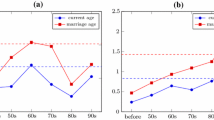Abstract
This paper constructs an economic model to study the emergence of marriage based on a new infra-marginal general equilibrium analysis. By depicting the commonness and complementarity of marriage, we explain how a single person shifts from being single to being married based on the division of labor. Meanwhile, reduced learning costs will make an individual more willing to abandon the single status, and the number of families in the marriage market will increase. The model reveals the necessary conditions for the existence of marriage and marital stability and explains the dynamic changes in the relative population and the prices of parties in the marriage market.


Similar content being viewed by others
Notes
The transaction costs include material investments, learning costs and search costs.
This paper conducts the model to explain the essence of marriage, which has been general issues. We not only focus on China’s marriage phenomenon, but also other countries.
The transaction cost the must parameters in the infra-marginal analysis model not just the marriage, but it is important to consider it in the marriage model. While the other three factors are mainly for the nature of marriage.
In this paper, the attraction parameter is equal to the similarity of the two parties as the influential factor.
References
Baker, M. J., & Jacobsen, J. P. (2007). Marriage, specialization, and the gender division of labor. Journal of Labor Economics, 25(4), 763–793.
Barham, V., Devlin, R. A., & Yang, J. (2009). A theory of rational marriage and divorce. European Economic Review, 53(1), 93–106.
Becker, G. S. (1974). A Theory of marriage, economics of the family: Marriage, children, and human capital. Chicago: University of Chicago Press.
Becker, G. S. (1976). The economic approach to human behavior. Chicago: University of Chicago Press.
Becker, G. S. (1981). A treatise on the family. Massachusetts: Harvard University Press.
Bjerk, D. (2009). Beauty vs. earnings: Gender differences in earnings and priorities over spousal characteristics in a matching model. Journal of Economic Behavior & Organization, 69(3), 248–259.
Chen, H. X. (2005). Marriage, moral and social classes: Analysis of the social evolution based on labor division. Social Science Front, 1, 206–214.
Cheng, W., & Yang, X. (2004). Inframarginal analysis of division of labor: A survey. Journal of Economic Behavior & Organization, 55(2), 137–174.
Cigno, A. (1991). Economics of the family. Oxford, England: Clarendon Press.
Cvrcek, T. (2012). America’s settling down: How better jobs and falling immigration led to a rise in marriage, 1880–1930. Explorations in Economic History, 49(3), 335–351.
Drewianka, S. (2003). Estimating social effects in matching markets: Externalities in spousal search. The Review of Economics and Statistics, 85(2), 409–423.
Durkheim, É. (1893). The division of labor in society. Shanghai: Shanghai Sanlian Bookstore.
Engels, F. (2003). The origin of the family, private property and the state. Beijing: People Press.
Friedman, D. D. (2006). The life economics of Friedman. Beijing: CITIC Publishing Press.
Guo, Y. L. (2007). Comparative advantage theory and division of labor in the family. Economic Survey, 4, 79–81.
Hadfield, G. K. (1999). A coordination model of the sexual division of labor. Journal of Economic Behavior & Organization, 40(2), 125–153.
Huang, S. (2003). A sutdy on the model of Merrital asymmetric and inframarginal analysis in the Chinese society. Kaohsiung: National Sun Yat-Sen University.
Ishida, J. (2003). The role of social norms in a model of marriage and divorce. Journal of Economic Behavior & Organization, 51(1), 131–142.
Kant, I. (1797). Metaphysics of morals. Beijing: Commercial Press.
Lai, X. F., Liu, X., & Xiang, Y. B. (2011). Economic analysis of marriage. Frontier, 4, 71–73.
Masters, A. (2008). Marriage commitment and divorce in a matching model with differential aging. Review of Economic Dynamics, 11(3), 614–628.
Matouschek, N., & Rasul, I. (2008). The economics of the marriage contract: Theories and evidence. Journal of Law and Economics, 51(1), 59–110.
Neal, D. (2004). The relationship between marriage market prospects and never-married motherhood. Journal of Human Resources, 39(4), 938–957.
Nosaka, H. (2007). Specialization and competition in marriage models. Journal of Economic Behavior & Organization, 63(1), 104–119.
Pollak, R. A. (1985). A transaction cost approach to families and households. Journal of Economic Literature, 6, 581–608.
Tian, K. Y. (2008). The law and economics of marriage. Institutional Economics Research, 4, 125–155.
Xu, H. Y., Liu, J., & Li, M. (2003). Economics of marriage and family relations. Jiangxi Social Science, 12, 166–168.
Xu, A. Q., & Ye, W. Z. (2002). The quality of marriage: The main predictors of marital stability. Journal of Shanghai Social Sciences, 4, 103–112.
Yang, X. (1988). A microeconomic approach to modeling the division of labor based on increasing returns to specialization. Princeton: Princeton University.
Yang, X. (2003). Economics: New classical and neoclassical framework. Beijing: Social science document press.
Zeng, Y. (2009). Economic analysis on marriage. Enterprise Reform and Management, 12, 18–19.
Author information
Authors and Affiliations
Corresponding author
Rights and permissions
About this article
Cite this article
Liu, TY., Chang, HL. & Su, CW. Why do People Get Married? An Inframarginal Perspective. Soc Indic Res 130, 1281–1295 (2017). https://doi.org/10.1007/s11205-016-1232-6
Accepted:
Published:
Issue Date:
DOI: https://doi.org/10.1007/s11205-016-1232-6




